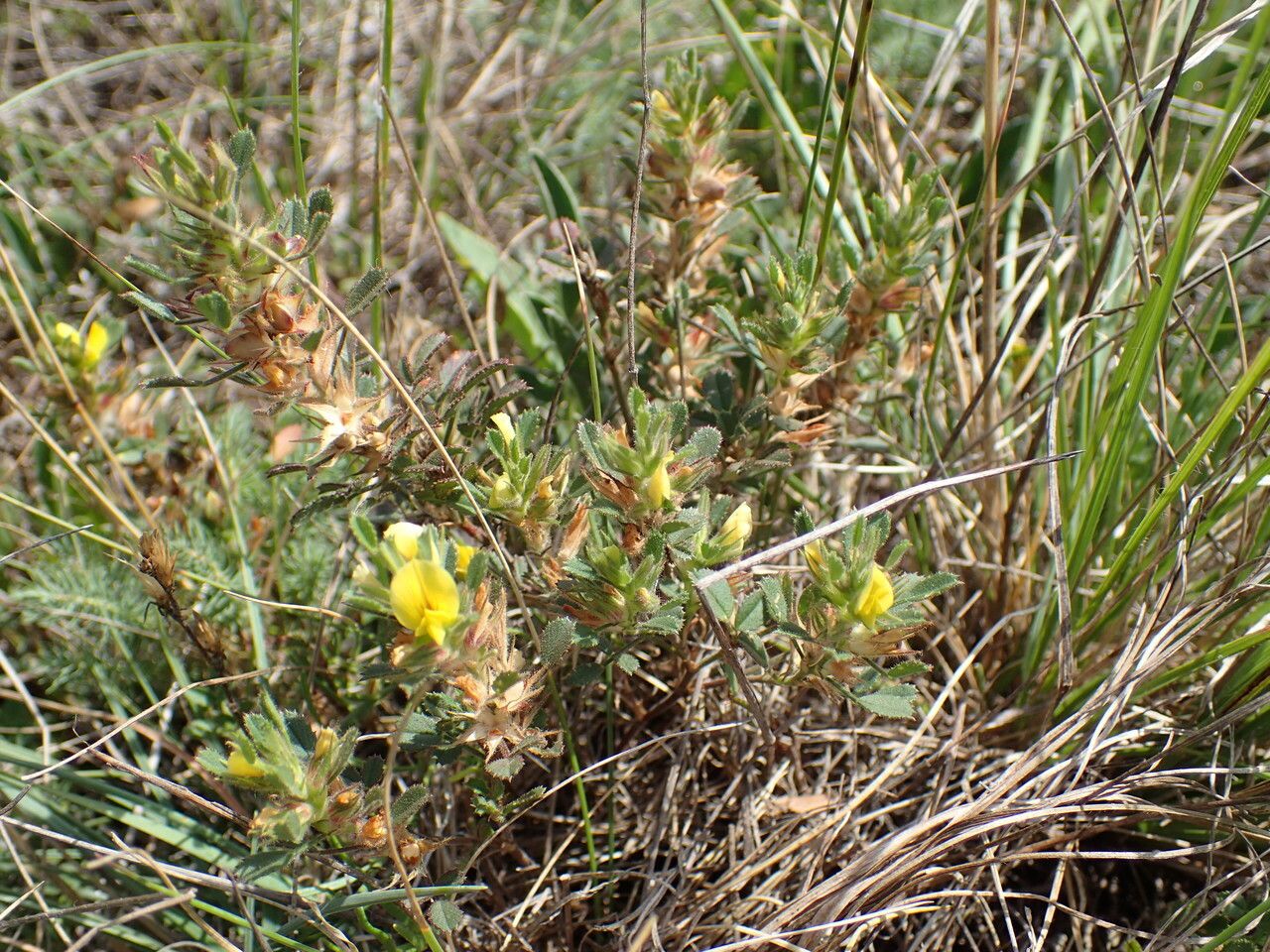Dwarf restharrow
ononis pusilla
Also known as: ["Small restharrow","Least restharrow"]
Overview
A small, low-growing perennial herbaceous plant in the Fabaceae family, native to Europe and parts of Asia.
Benefits & Perks
["drought tolerant","wildlife attractant (bees, butterflies, birds)"]
Botanical Classification
| Phylum: | Tracheophyta |
| Class: | Magnoliopsida |
| Order: | Fabales |
| Family: | Fabaceae |
| Genus: | Ononis |
| Botanical Name: | Ononis pusilla |
Plant Characteristics
Basic Information
- Category: Herbs & Weeds
- Suitable Location: rock gardens, borders, or open meadows
- Suitable For:
- Is Weed: No
- Allergenicity: low
Environmental Needs
- Climate: {"temperatureRange":"5–35°C"}
- Hardiness: {"zones":"7–10"}
- Misting: rarely required, only if ambient humidity is very low
- Drainage: Fast-draining.
- Soil Type: Well-draining, sandy loam with organic matter.
Maintenance Level
- Maintenance Level: low
- Toughness Level: moderate
- Pruning Frequency: Annually in late winter or early spring; light pruning as needed.
- Pruning Intensity: Moderate; remove up to one-third of growth if overgrown.
Care Details
Ideal Sunlight Coverage:
Full sun (6–8 hours/day); tolerates partial shade but may become leggy.
Sunlight Tolerance Tips:
Acclimate gradually if moving from shade to sun; protect from intense midday sun in hot climates; ensure good air circulation.
Care Requirements
Care Difficulty
easymoderate
Sunlight
full sun to partial shade
Rotate plant for even light; use sheer curtains in intense sun; avoid direct indoor light for prolonged periods.
Watering
every 7–10 days during active growth, reduce in winter
Water deeply but infrequently; avoid overwatering; ensure good drainage.
Soil
well-drained, sandy or loamy soil
pH: Slightly acidic to neutral (6.0–7.0).
Ensure pots have drainage holes; avoid heavy clay soils; test pH periodically.
Temperature
Prefers moderate temperatures (60–75°F/15–24°C); tolerates mild frosts but avoid prolonged cold.
Avoid sudden temperature changes; protect from drafts; maintain consistent room temperature indoors.
Fertilizing
every 2 months during growing season, none in winter
Apply fertilizer after watering; flush soil occasionally to prevent salt buildup; use organic options for gentle feeding.
Propagation
Methods
Stem cuttings or division.
Step-by-Step Propagation Guide
- Take 4–6 inch cuttings.
- Remove lower leaves.
- Dip in hormone.
- Plant in medium.
- Keep moist.
Best Time: Spring or early summer when plant is actively growing.
Environment
Warm (70–75°F/21–24°C), high humidity, indirect light.
Medium
Well-draining potting mix with perlite or sand.
Hormone
Optional, but recommended for faster rooting.
Timeline
Roots in 3–6 weeks; establish in 2–3 months.
Tools Needed
Pruners, rooting hormone, small pots, misting spray bottle.
Quick Tips
Use healthy, non-flowering stems; maintain humidity with a plastic bag; avoid direct sun.
Pruning & Repotting
Pruning Guide
Method
Pinch back tips for bushiness; cut just above a leaf node or bud.
Pruning Plan
Prune to maintain shape, encourage bushiness, and remove dead or weak growth.
Tools
Pruning shears, sharp scissors, disinfectant.
Checklist
Disinfect tools; prune during dormancy; remove dead or diseased parts.
Repotting Guide
Best Season
Spring, before new growth begins.
Pot Size
One size larger pot; ensure it’s not too big.
Method
Remove plant gently; trim roots if needed; use fresh soil; ensure drainage.
Suggestions
Repot every 2–3 years or when roots fill the pot; beneficial for growth.
Checklist
Check root bound status; use fresh soil mix; water after repotting.
Advanced Care Tips
Watering Mastery
Watering Checklist
Check soil moisture before watering; water early in the day; ensure drainage.
How to Apply Water Properly
Water directly at the root zone until soil is moist but not waterlogged. Ensure excess water drains away to prevent standing moisture.
Watering Schedule Tips
Water sparingly, allowing soil to dry completely between waterings. Reduce frequency in winter to prevent root rot.
Soil Improvement
Add perlite or sand for drainage; incorporate compost for fertility.
Temperature Stress Management
Signs of Temperature Issues
Wilting, yellowing leaves, stunted growth, or leaf drop.
Cold Stress
Slows growth, may cause leaf discoloration or dieback in prolonged cold.
Solution: Move to a warmer location; apply a layer of mulch for insulation; avoid overwatering.
Hot Stress
Leaves may scorch, wilt, or drop; growth may slow in extreme heat.
Solution: Provide partial shade during peak heat; increase watering cautiously; improve air circulation.
Fertilizing Guide
Fertilizing Checklist
Check fertilizer label for NPK ratio; dilute correctly; apply during active growth.
Fertilizing Method
Use a balanced, water-soluble fertilizer diluted to half strength every 4–6 weeks during growing season; avoid fertilizing in winter.
Common Problems & Solutions
Toxicity Warning
Cats
Slightly ToxicCats may experience mild gastrointestinal upset if they ingest Ononis pusilla. The plant is not highly toxic but can cause mild irritation.
⚠️ Symptoms:
🌿 Toxic Parts:
⚡ Toxic If:
if eaten
Dogs
Slightly ToxicIn dogs, ingestion of Ononis pusilla may lead to mild gastrointestinal upset. The plant does not typically cause severe toxicity but can cause discomfort.
⚠️ Symptoms:
🌿 Toxic Parts:
⚡ Toxic If:
if eaten
Humans
Slightly ToxicOnonis pusilla contains compounds that can cause mild gastrointestinal distress and potential allergic reactions in humans. The physiological impact is generally limited to mild irritation of the digestive tract.
⚠️ Symptoms:
🌿 Toxic Parts:
⚡ Toxic If:
if eaten
Frequently Asked Questions
Q: Is Ononis pusilla suitable for rock gardens?
A: Yes, its low-growing habit and drought tolerance make it well-suited for rock gardens.
Q: Does Ononis pusilla require regular watering?
A: No, it is drought-tolerant and prefers well-drained soil with minimal watering.
Q: Does Ononis pusilla attract pollinators?
A: Yes, its flowers attract bees and butterflies, making it a good choice for wildlife gardens.
Quick Reference
| Family: | Fabaceae |
| Care: | easy |
| Light: | full sun to partial shade |
| Water: | every 7–10 days during activ |
Get Expert Care Tips
Download the Plantious app for personalized care reminders and plant identification!
Google Play App Store








